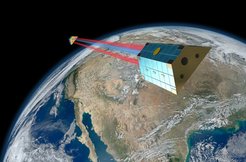GRACE Follow-On is on track
NASA review greenlights satellite construction
The GRACE Follow-On tandem satellites are on track for their launch in 2017. This is the result of the system integration review conducted 21-23 July by NASA. The Max Planck Institute for Gravitational Physics (Albert Einstein Institute, AEI) in Hannover is responsible for the design and technical supervision of a novel laser interferometer on board the satellites, which shall significantly increase measurement accuracy.

“We are very happy that the NASA review gave the green light for our laser interferometer and all other subsystems,” says Priv.-Doz. Gerhard Heinzel, leader of the research group Interferometry in Space at the Max Planck Institute for Gravitational Physics (Albert Einstein Institute, AEI) in Hannover. “After passing this crucial milestone we can now enter the home straight: Our industrial partners now begin to construct the satellites for GRACE Follow-On's launch in 2017.”
GRACE Follow-On will continue the measurements done by the GRACE (Gravity Recovery and Climate Experiment) mission since 2002. Like its predecessor, GRACE Follow-On will be a tandem of two satellites, circling the Earth separated by 220 kilometers in the same orbit 490 kilometers above ground. Measuring changes in their mutual distance enables precise measurements of the gravity field of the Earth below. This way indicators of climate change such as melting polar ice caps, the course of sea currents, the global water cycle, and changing groundwater levels can be monitored.
GRACE Follow-On features a novel experimental instrument: the Laser Ranging Interferometer (LRI) with contributions from Germany and from NASA. The LRI shall make the inter-satellite distance measurements even more precise than before. GRACE employed microwaves to measure distance changes between the satellites as small as 0.002 millimeters. For GRACE Follow-On this is still the basis of its measurements, but the LRI will have an up to 50 times higher accuracy. This also employes technologies intially developed at the AEI for the measurement of gravitational waves in space. “Here, fundamental research directly helps to capture important data for our understanding of global climate change,” says Heinzel.
The AEI developed the optical design of the LRI and is responsible for the technical management. SpaceTech GmbH in Immenstaad (STI) builds the flight hardware with in-kind contributions from the Deutsches Zentrum für Luft- und Raumfahrt. The german contributions are coordinated by the Deutsches GeoForschungsZentrum Potsdam. In the coming months, the different flight hardware subsystems will be integrated into the satellites and repeatedly put through their paces along the way.












